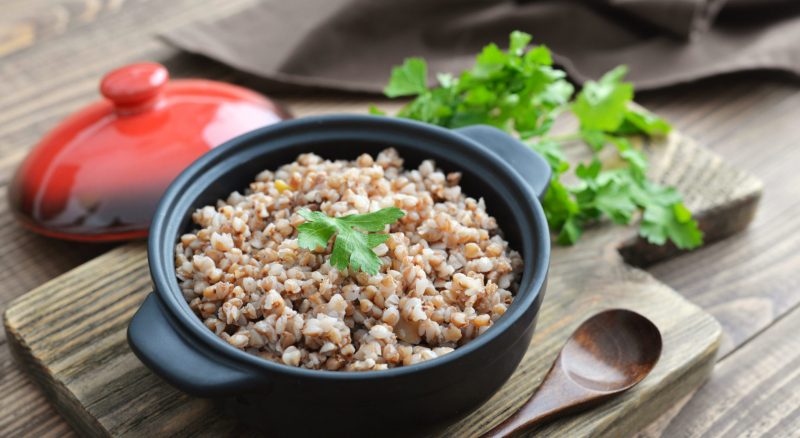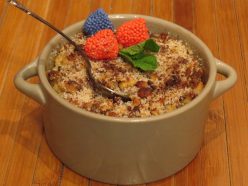So that children grow up healthy and strong, mothers from childhood have been trying to instill in them a love of cereals. They occupy a significant place in the daily diet, but not always the kids are ready to eat this dish. An exception can only be a recipe for classical Guryev porridge, because such a treat is so tasty that it’s hard to even answer: is this the main dish or is it dessert?
Material Content:
History tour
The history of Guryev’s porridge is so amazing that it seems incredible. Minister of Finance Guryev, a man who knows a lot about profitable investments, did not consider it a waste to give a measure of gold (26 liters of gold pieces, each weighing 3.39 g) for the cook Zakhar Kuzmin, who came up with the recipe for this dish, and his family.

I must say, Count Guryev did not lose, because Alexander III, Count Witte and other representatives of the aristocracy so loved the treat at the royal court that they soon began to call the porridge the “queen of desserts”.
The official presentation of Guryev’s porridge took place in 1814, when it was presented in Paris as a “Russian dessert”. Since then, this dish has become the hallmark of Russian cuisine.
Classic Guryev porridge recipe
Cooking semolina according to this recipe is a rather long process. But as a result, a simple dish turns into a delicious dessert.
Its ingredients are:
- 1300 ml of milk;
- 100 g semolina;
- 100 g of walnuts;
- 50 g of raisins;
- 150 g of sugar.
Cooking in steps:
- Prepare the nuts. First, they should be poured with boiling water for three to four minutes, so that you can easily remove the thin brown crust.The peeled fruits should be dried on a towel, then crushed into crumbs (for example, using a meat grinder), mixed with 50 g of sugar and baked in the oven for three minutes at 200 ° C.
- Raisins, like nuts, need to pour boiling water for about ten minutes. When the dry grapes are steamed, it is time to dry them with paper towels.
- Pour milk into a heat-resistant bowl and put in a hot oven, where it is heated until a dense milk crust is formed. It should be carefully removed and transferred to a separate plate. It is necessary to obtain five to six such films in the process of languishing.
- Pour the remaining milk into a pan, bring to a boil, pour semolina and 50 g of sugar into it. After this, the semolina is boiled like ordinary semolina.
- Set aside a couple of tablespoons of baked nuts for decoration, mix the remaining nuts and raisins with the finished porridge.
- In a beautiful deep and refractory bowl, put 1/6 of the porridge, cover with a film and repeat in sequence with all the films. Sprinkle the top layer of porridge with the remaining 50 g of sugar and leave for 10 minutes in the oven. The temperature is 200 degrees. Cook until a beautiful caramel crust.
How to cook in a slow cooker
In the slow cooker, you get excellent Guryev semolina in its modernized and simplified version.

This will require:
- 500 ml of milk;
- 100 g semolina;
- 50 g of sugar;
- 25 g vanilla sugar;
- 2 eggs;
- 50 g crushed walnuts;
- 200 g of fresh fruit or jam;
- 20 g butter;
- 3-4 g of salt.
How to cook:
- From porridge, milk, vanilla sugar, salt and semolina, cook porridge in a slow cooker using the option “Milk porridge” or “Braising”. Transfer the prepared porridge from the multi-pan to allow the dish to cool.
- Beat eggs with sugar in a lush foam mass, which should be carefully mixed with chopped nuts in an already cooled semolina.
- Lubricate a clean and dry multicooker with a piece of soft butter. At the bottom lay a quarter of the porridge, lay it with fruit or jam and repeat this a few more times.
- Close the lid of the device and start the program “Porridge”. Garnish the finished dish before serving with fruit.
19th century old recipe
The 19th century (or rather, 1899) was marked by the publication of the book “The Practical Basics of Culinary Art”, which contains an old recipe for this delicacy.
What distinguishes it from later variations is the serving in a cast-iron pan, as well as the use of kaimak and maseduana for the layer.
The proportions of the ingredients used in the preparation of the dish will be as follows:
- 1500 ml of heavy cream;
- 500 ml of milk;
- 90 g semolina;
- 350 g of granulated sugar (including 50 g per semolina);
- 20 g of vanilla sugar;
- 600 ml of water;
- 100 g chopped nuts (almonds, hazelnuts);
- 500 g of apples and pears.
The sequence of culinary processes:
- We prepare kaymak - films from cream stewed in the oven. Cream with a fat content of 20% and above should be poured into a cast-iron pan with high sides and a thick bottom, and then sent to a preheated oven. The temperature in it should be such that they do not boil, but slowly languish. The resulting films must be carefully removed and laid out on separate flat plates.Foams from boiled cream not only give the porridge a delicate creamy taste, but are also rich in iron, vitamin A and calcium. In the process of preparation, it is important not to overexpose them until brown, since such foams will be bitter.
- While the cream is languishing, you can boil the milk. Then pour in it a thin stream of semolina mixed with regular and vanilla sugar. Boil the porridge literally a few minutes after boiling, then remove from heat and put on frying, wrapping the pan with a warm blanket.
- Cook syrup from water and sugar. Dip apples and pears into thin slices into it. Boil the fruits in boiling composition for 10 minutes, after which the maseduana (fruits boiled in syrup) is ready for the interlayer.
- When all the components of the dish are ready, lay on the bottom of the baking dish with layers of foam - porridge - maseduan and crushed nuts - porridge - foam.Laying layers is important in this order. The last should be a layer of porridge, sprinkled with nuts and covered with fruit in syrup.
- The "collected" porridge can only be baked in the oven at 100 degrees.
Serve it warm by slicing into portions and pouring jam or other sweet sauce.
Guriev-style buckwheat porridge

There is not only Guryev’s semolina porridge, there is also a less popular version of Guriev’s buckwheat porridge with mushrooms and brains:
- 300 g of buckwheat;
- 600 ml of mushroom broth;
- 40 g butter;
- 5 g of salt;
- 100 g of carrots;
- 50 g of mushrooms;
- 30 ml of vegetable oil;
- 300 g of pork or beef brains.
Working process:
- Boil the mushroom broth, salt it, add prepared buckwheat and put butter. Mix well, cover and simmer over medium heat until half cooked.
- Fried carrots and shredded thin slices of mushrooms, fry in a pan with vegetable oil.
- In a clay pot lay layers of buckwheat porridge, carrot and mushroom frying and brains. They should be the last layer.
- Cover the pot with a lid and send to bake in the oven until all the components of the dish are ready. Buckwheat should become friable.
From tops and greens
Along with the above Guriev-style buckwheat porridge recipe, there is also its lean version with beet tops and greens.
Beet tops contain so many vitamins and beneficial micro and macro elements that will help the body deal with stress during Lent.
List of required ingredients:
- 210 g buckwheat;
- 400 ml of water;
- 100 g beet tops;
- 50 g of dill;
- 50 g of parsley;
- salt to taste.
Cooking:
- Rinse and finely chop the tops. Sort out cereals and rinse in cold water.
- Bring the water to a boil, send buckwheat and chopped tops to it. Mix everything, cover and simmer for a quarter of an hour.
- Then remove the almost finished porridge from the fire and without opening the lid, let it stand for another 10 minutes.
- Before serving, add chopped fresh herbs (dill and parsley) and mix.
How can I diversify the dish
Guryev’s semolina porridge is good because it makes it possible to significantly diversify its composition.

Since there are no strict rules regarding the ingredients used, you can put in it:
- different nuts (walnuts, cedar, almonds, hazelnuts, hazel);
- fruits and berries, which can be fresh, boiled in syrup or in the form of jam, or candied fruit (dried fruit).
- You can also cross porridge with liquid honey.
- A variety of dishes can add sauces with which porridge can be served. The cook of Count Guriev cooked chopped apricots sauce for this delicacy. And modern housewives can serve porridge with any sweet sauces, condensed milk, liquid honey or custard.
The serving of the dish can also be varied. In the 19th century, this porridge was often offered instead of ice cream. For this purpose, after cooling, it was placed on a glacier, and then cut into portioned pieces and served with fresh fruit. Now, in many restaurants of Russian cuisine, the favorite delicacy of Count Guryev is served to guests in large portioned cast-iron frying pans in hot or warm form.
The multivariance of the ingredients and sauces used, as well as the presentation itself, led to the fact that each hostess’s Guryev porridge can be author's, fully satisfying her family’s taste preferences.





















